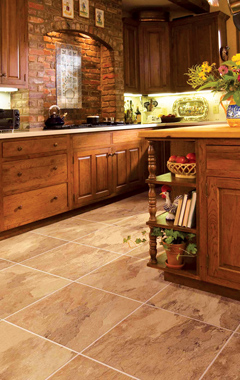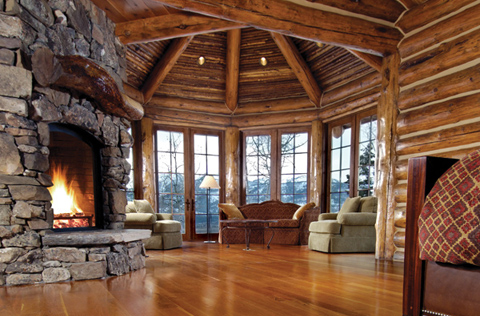When choosing flooring for your log or timber home, you don’t have to settle for second best. Selecting the best floors for your lifestyle will benefit your home for many years to come, says Richard Ragone, East Coast sales representative for Montana Log Homes.
“Quality floors are one of the most important areas on the inside of a home,” Ragone says. “Short cuts should not be taken.”
More styles of flooring are available now than ever before to fit your needs and your budget. The World Floor Covering Association (WFCA) reports that resilient vinyl flooring is the least expensive flooring option, costing $1 to $7 per square foot, installed. Stone flooring is the most costly, ranging from $8 to $50 per square foot, installed.
Besides vinyl, other low-cost materials include carpet, laminate, ceramic tile, bamboo, linoleum, and cork. Natural hardwood and engineered wood are more expensive than these materials but cost less than stone.
In addition to cost, homeowners would be wise to look at durability, ease of installation, and future maintenance for their floors.

Photo courtesy of Shaw Floors
Many log and timber frame home owners prefer hardwood floors because they are wear resistant and long lasting. Wood floors are vulnerable to moisture and can shrink and expand. Engineered wood shrinks and expands less than solid wood and is easier to install. It can only be refinished once or twice, while natural hardwood can be finished again and again.
Tom and Jan Nasser of Carmel, Indiana, initially planned for only hardwood floors in their log home getaway near
Clayton, Georgia. But when they calculated the cost, they adjusted their plan.
“The majority of flooring in our log home is ‘Homerwood’ red oak saddle,” Jan reports. “We chose to do carpet in all three bedrooms and tile in the bathroom, because it just seemed to be more practical.”
Their home was completed in December 2011, and the Nassers are still pleased with their floors. “I still like the idea of carpet in bedrooms, because it feels warmer,” Jan adds.
Using carpet in bedrooms and living rooms has several advantages, notes Tom Jennings, WFCA vice president of member services. Carpet feels warm and can absorb various sounds in a home, unlike hardwood and tile. Many of today’s carpets are stain and soil resistant. Carpet acts as a passive air filter, trapping dust and other particles and removing them from the breathing zone. Studies have shown that people with asthma and allergy problems have seen symptoms improve with carpet, Jennings says.
Other options for living rooms and bedrooms include bamboo and stone flooring. Bamboo is less expensive than wood, but it may darken or fade when exposed to sunlight and should not be left wet. Stone, although costly, can increase a home’s value over time.
Jennings recommends ceramic or porcelain tile for bathrooms and any other wet areas of a home. This is because tile easily withstands moisture and changes in humidity. If homeowners are trying to save money, resilient vinyl flooring can be a good alternative.

Photo by Heidi Long
Unlike hardwood and laminate flooring, tile is not subject to expansion and contraction, Jennings says. “When properly installed, it is truly a lifetime floor.”
Some alternatives to tile and vinyl include laminate flooring, linoleum, and cork. Laminate flooring and linoleum can be damaged by standing water. Cork, on the other hand, is stain and water resistant and easy to clean, according to the WFCA.
One key to a good flooring experience, Ragone advises, is to make sure floors are acclimated to a home’s environment prior to installation and that materials are compatible with a home’s conditions. Rose Todd, a homeowner in Lost Prairie, Montana, learned this through her own experience.
Todd was living in Alaska while building her Montana home, so she did a lot of shopping online. Because of a miscommunication between her and the lumber company, Todd thought engineered bamboo could be installed over radiant heat as long as she used the best underlayment. She flew from Fairbanks, Alaska, to Spokane, Washington, to pick up and transport the bamboo to her new home. After arriving there, she learned that the company did not recommend that bamboo be laid over radiant heat, after all. Since she couldn’t get her money back, she risked having the bamboo professionally installed.
The results were disappointing. “I’m told every kind of wood/bamboo flooring will shrink but I wasn’t expecting half-inch gaps. I’ve caulked the gaps with Big Stretch Caulk, which has made the floor look better,” she says. Todd advises homeowners to thoroughly research flooring materials before purchasing. More information on flooring materials and maintenance is available at www.wfca.org.

